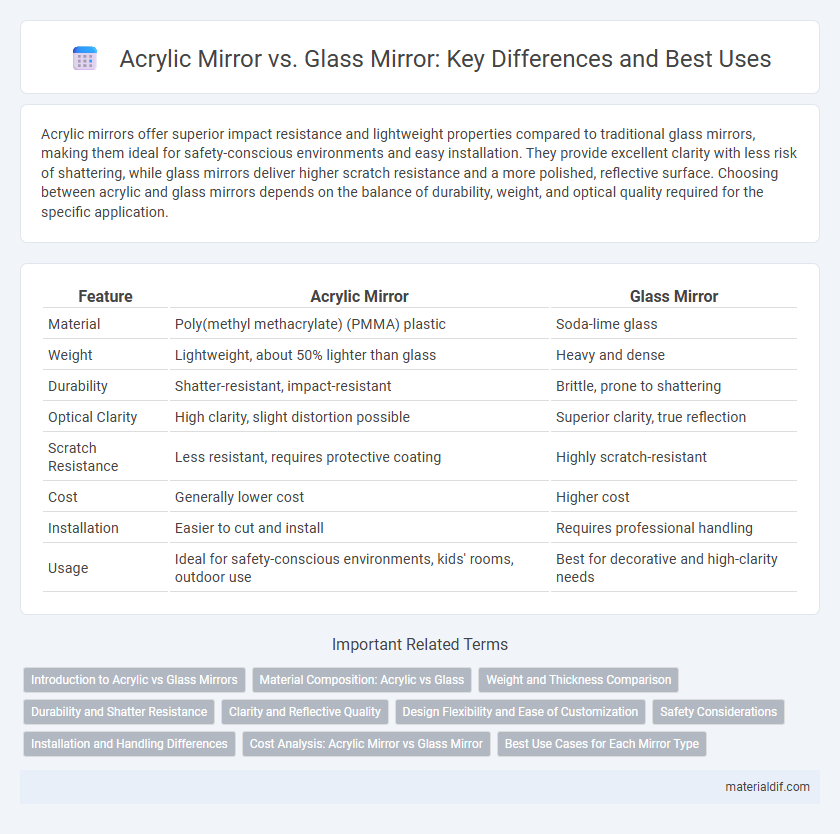Acrylic mirrors offer superior impact resistance and lightweight properties compared to traditional glass mirrors, making them ideal for safety-conscious environments and easy installation. They provide excellent clarity with less risk of shattering, while glass mirrors deliver higher scratch resistance and a more polished, reflective surface. Choosing between acrylic and glass mirrors depends on the balance of durability, weight, and optical quality required for the specific application.
Table of Comparison
| Feature | Acrylic Mirror | Glass Mirror |
|---|---|---|
| Material | Poly(methyl methacrylate) (PMMA) plastic | Soda-lime glass |
| Weight | Lightweight, about 50% lighter than glass | Heavy and dense |
| Durability | Shatter-resistant, impact-resistant | Brittle, prone to shattering |
| Optical Clarity | High clarity, slight distortion possible | Superior clarity, true reflection |
| Scratch Resistance | Less resistant, requires protective coating | Highly scratch-resistant |
| Cost | Generally lower cost | Higher cost |
| Installation | Easier to cut and install | Requires professional handling |
| Usage | Ideal for safety-conscious environments, kids' rooms, outdoor use | Best for decorative and high-clarity needs |
Introduction to Acrylic vs Glass Mirrors
Acrylic mirrors offer lightweight and shatter-resistant alternatives to traditional glass mirrors, making them ideal for safety-conscious environments. Unlike glass mirrors, acrylic mirrors provide greater flexibility and impact resistance while maintaining clear reflection quality. Glass mirrors typically deliver superior scratch resistance and optical clarity but are heavier and more fragile compared to acrylic options.
Material Composition: Acrylic vs Glass
Acrylic mirrors are made from polymethyl methacrylate (PMMA), a lightweight, shatter-resistant plastic known for its flexibility and impact resistance, while glass mirrors consist of silica-based glass with a reflective metallic backing, usually aluminum or silver. Acrylic's polymer structure allows for easier cutting and shaping without cracking, contrasting with glass, which is rigid and prone to breakage under stress. The difference in material composition results in acrylic mirrors being safer and more versatile for applications requiring durability and reduced weight compared to traditional glass mirrors.
Weight and Thickness Comparison
Acrylic mirrors are significantly lighter than glass mirrors, often weighing up to 50% less, making them ideal for applications requiring easy handling and reduced structural support. Acrylic mirrors typically have a thickness range from 1/8 inch to 1/4 inch, whereas glass mirrors usually start at about 1/4 inch thick and can be much heavier due to their density. The reduced weight and thinner profile of acrylic mirrors contribute to enhanced safety and installation flexibility compared to conventional glass mirrors.
Durability and Shatter Resistance
Acrylic mirrors outperform glass mirrors in durability, offering exceptional resistance to impact and preventing shattering even under significant force. Unlike traditional glass mirrors, acrylic mirrors are less prone to cracking or breaking, making them ideal for high-traffic or safety-sensitive environments. Their lightweight nature combined with superior shatter resistance enhances longevity and reduces the risk of injury.
Clarity and Reflective Quality
Acrylic mirrors exhibit high clarity with 92% light reflectance, offering sharp, distortion-free images comparable to glass mirrors. Glass mirrors typically provide a slightly higher reflectivity, around 95%, resulting in marginally better image sharpness in professional applications. However, acrylic mirrors are more impact-resistant and lightweight, making them ideal for versatile usage without significant compromise in clarity and reflective quality.
Design Flexibility and Ease of Customization
Acrylic mirrors offer superior design flexibility compared to glass mirrors due to their lightweight nature and ease of cutting into various shapes and sizes without risk of shattering. Customization options for acrylic mirrors include tinted finishes, laser etching, and curved or beveled edges, which are more challenging and costly to achieve with traditional glass mirrors. This adaptability makes acrylic mirrors ideal for creative interior designs and installations requiring unique contours or safety considerations.
Safety Considerations
Acrylic mirrors are significantly safer than glass mirrors due to their shatter-resistant properties, reducing the risk of injury from sharp glass shards. They are lightweight and flexible, making them less prone to breaking under impact, which is ideal for environments with children or high foot traffic. Glass mirrors, while offering superior clarity, pose safety hazards since they can easily shatter and cause cuts or other injuries.
Installation and Handling Differences
Acrylic mirrors are significantly lighter and more flexible than glass mirrors, making installation easier and reducing the risk of breakage during handling. Their shatter-resistant nature allows for safer application in environments where impact is likely, while glass mirrors require careful handling due to their fragility and heavier weight. Acrylic mirrors can be cut and drilled on-site with standard tools, offering greater versatility compared to the specialized equipment needed for glass mirrors.
Cost Analysis: Acrylic Mirror vs Glass Mirror
Acrylic mirrors generally cost 50-70% less than glass mirrors due to lower manufacturing and shipping expenses, making them a budget-friendly option for large installations. Glass mirrors, while more expensive, offer superior durability and clarity, often justifying their higher price in premium applications. Maintenance costs for acrylic are typically lower since they are less prone to shattering, reducing replacement frequency.
Best Use Cases for Each Mirror Type
Acrylic mirrors excel in environments requiring lightweight and shatter-resistant materials, making them ideal for kids' rooms, gyms, and outdoor settings. Glass mirrors offer superior clarity and scratch resistance, favoring use in bathrooms, dressing rooms, and high-end interior spaces. Choosing between acrylic and glass mirrors depends on factors like safety, durability, and visual quality requirements.
Acrylic Mirror vs Glass Mirror Infographic

 materialdif.com
materialdif.com